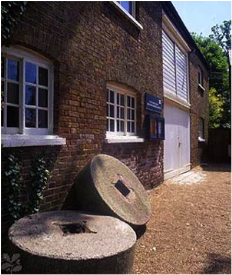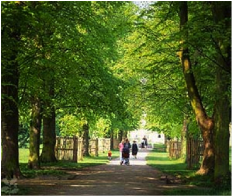History of Hatfeild Primary School
 Our History
Our History
 In the middle of the 19th century the Hatfeild family (that’s how the name was spelt) bought much of the local area from the Garth family. Alexander Hatfeild was the first Hatfeild in Morden. He leased snuff mills in Morden Hall Park. He married Elizabeth Gilliat and they used her surname as the first name of their son, who was born in 1826.
In the middle of the 19th century the Hatfeild family (that’s how the name was spelt) bought much of the local area from the Garth family. Alexander Hatfeild was the first Hatfeild in Morden. He leased snuff mills in Morden Hall Park. He married Elizabeth Gilliat and they used her surname as the first name of their son, who was born in 1826.
Gilliat Hatfeild married Jesse Ellen Davis and on March 1st 1864 their son was born and was named Gilliat Edward Hatfeild.
Hatfeild School was named after Gilliat Edward. He was fond of children and used to open up his land to them. He died on 9th February 1941 and is buried at St. Lawrence’s Church, Morden.

The site on which Hatfeild Primary School is built was originally farmland. In the 1950s, space was needed to create a new school. Lower Morden Farm was chosen as the site. Work began on demolishing the old farm buildings and creating a new school using the land donated by Gilliat Edward Hatfeild.

 The school building was completed and was officially opened on Monday 13th July 1953. In 1981 the original school site flooded, the building began to subside and a new school had to be built. Due to the weight it could only be a single storey. A new school was built on the school field. The new build was completed in 1993 and consisted of what is now our KS1 building.
The school building was completed and was officially opened on Monday 13th July 1953. In 1981 the original school site flooded, the building began to subside and a new school had to be built. Due to the weight it could only be a single storey. A new school was built on the school field. The new build was completed in 1993 and consisted of what is now our KS1 building.

1953 - The official opening of Hatfeild Primary School by Captain Ryder VC. Mr Barker is appointed Headteacher.
1958 - The first Summer Fair raises £250
1962 - The first meeting of the parent association, now the H.S.A
1965 - The London Borough of Merton is created
1969 - Comprehensive education is introduced in Merton - Hatfeild First School is formed.
1971 - Mr Barker retired after 19 years
1972 - Mr Streeter is appointed as Headteacher
1974 - The school celebrates its 21st birthday with 154 pupils on roll
1975 - The cutting out ceremony for the new Nursery building
1976 - The official opening of the Nursery by the Mayor of Merton
1978 - The school celebrates its Silver Jubilee - 25 silver birch trees were planted in the school grounds.
1983 - Mr Streeter leaves to lecture at Roehampton Institute of Education
1984 - Mrs Nadal is appointed as Headteacher
1985 - The official formation of the H.S.A
1990 - Severe cracks appear indicating subsidence
1991 - The decision is made to build a new school on the site
1992 - Building work commences in October
1994 - The new building open
1995 - Mrs Nadal retires and Mr Parker is appointed as Headtecher
1997 - The first OFSTED inspection of the school takes place
1998 - The first school journey for Year 3 pupils to Avon Tyrrel
2001 - Hatfeild becomes a two-form all through primary school
2003 - The school celebrates its Golden Jubilee
2005 - Mrs Richards is appointed as Headteacher
2007 - The school is flooded on the last day of summer term - flood defences are installed
2010 - Mrs Perry is appointed Headteacher
2013 - The school celebrates its Diamond Jubilee
2022 - Mrs Perry retires and Mrs Wright is appointed Head of School, Mrs Saville is appointed Executive Headteacher
2023 - Ms Newman and Mrs Waterman are appointed Co Heads of School and the school celebrates its 70th birthday
2024 - Hatfeild Primary School Joins the Cherrywood Federation when the school federates with Joseph Hood Primary School
Gilliat Hatfeild and the National Trust
 Morden Cottage was home to Gilliat Hatfeild, who considered the cottage better suited to a bachelor than the Hall. He was a keen huntsman and fisherman, attracted to the idea of being a country gentleman. Many of the buildings on the estate reflect his interests, including gatehouses, lodges and a stable block built for his hunting horses, which has a weather vane in the shape of a trout. Even the former Dairy was converted for trout breeding.
Morden Cottage was home to Gilliat Hatfeild, who considered the cottage better suited to a bachelor than the Hall. He was a keen huntsman and fisherman, attracted to the idea of being a country gentleman. Many of the buildings on the estate reflect his interests, including gatehouses, lodges and a stable block built for his hunting horses, which has a weather vane in the shape of a trout. Even the former Dairy was converted for trout breeding.
The formal garden of the cottage is surrounded by an unusual collection of ornamental trees, including one of the oldest yews in England. Many of the trees in the park were planted in the 19th and 20th Century by the Hatfeild family.
In 1941 Gilliat Hatfeild left the core of the estate (125 acres) to the National Trust.
